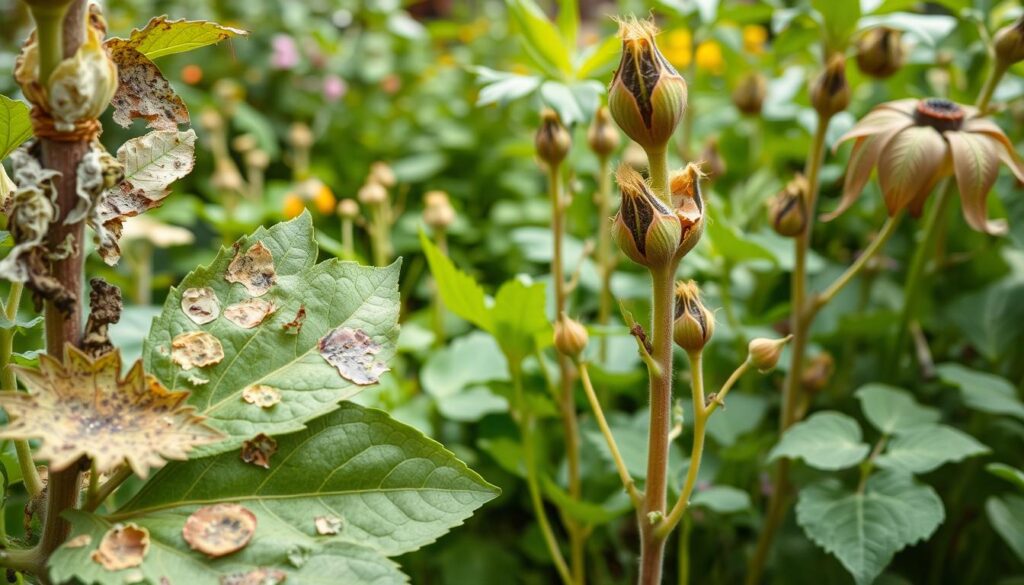For garden lovers, keeping plants healthy is key. One effective way to do this is by spotting and stopping common plant diseases early. Knowing these diseases and their signs can really help your garden thrive. This piece will look into different plant sicknesses, how to recognize them, and how to prevent them. We aim to boost good gardening habits that keep your plants in top shape.
Understanding Plant Diseases
Gardeners everywhere are concerned about plant diseases. These issues can hurt gardens a lot. They can cause poor growth, fewer crops, and even the death of plants. Knowing about these diseases is crucial for handling and stopping them.
Anúncios
Definition and Impact on Gardens
Plant diseases come from different things, like germs and stress from the environment. They can badly affect gardens. Diseases not only harm the plant they first attack but can also spread fast to others. This can make a garden look worse and lead to losses. It shows how important it is to pay attention to and fix plant health problems quickly.
Classification of Plant Diseases
Diseases in plants are put into groups to make them easier to understand. There are two big groups: abiotic and biotic. Abiotic diseases don’t come from germs. They are caused by things like not enough nutrients or harmful chemicals. Biotic diseases are caused by germs, like fungi, bacteria, and viruses. Knowing these groups helps gardeners make better plans for taking care of their plants.
Anúncios
Common Symptoms of Plant Diseases
It’s vital to know plant disease symptoms for good care and prevention. Gardeners must watch for signs like wilting, blotches, mold, and rust. By recognizing these signs early, you can act fast to keep your plants healthy.
Wilting and Blotchiness
Wilting is a key sign of illness in plants. Things like verticillium wilt make leaves wilt and stems droop, often because of vascular damage. Catching and treating these signs early can sometimes save your plant.
Blotchiness means dark, sunken spots on leaves and stems, often due to fungal attacks like anthracnose. These spots lead to leaves falling early and can kill parts of the plant, harming its health.
Moldy Coatings and Rust
Moldy coatings, like with powdery mildew, appear as white, powdery layers on leaves, stems, and buds. This can twist leaves and turn them yellow. Keeping air moving and managing water well can help avoid this.
Rust diseases cause yellow, brown, or orange spots that carry fungal spores. These spots can stunt growth and cause wilting. Finding rust early helps stop it from spreading and keeps your garden safe.
Identifying Fungal Plant Diseases
Fungi play a big part in plant health, but they can be bad news for gardens. They cause a lot of damage, leading to symptoms like wilting, scabs, and rotten spots. It’s important to spot these fungal diseases early to keep plants healthy.
How Fungi Affect Plants
Fungi and plants don’t always get along, especially when it comes to fungi diseases. Fungi attack plant tissues, stealing their nutrients and water. This attack can make plants show different symptoms.
Blocked water paths in plants can cause wilting, and scabs appear as plants try to heal from fungal attacks.
Common Fungal Diseases: Black Spot, Powdery Mildew
Black spot and powdery mildew are two common fungi problems, each with its own signs. Black spot shows up as dark spots on leaves, often because of too much moisture and not enough air. This issue can make leaves turn yellow and fall off early.
Powdery mildew looks like white, powdery dust on leaves and stems. It loves dry, humid conditions, which helps it spread faster. Knowing about these fungi helps gardeners fight back and protect their plants.
Identifying Bacterial Plant Diseases
It’s important to spot bacterial diseases early to keep plants healthy. These infections can show up as leaf spots, wilting, or cankers. Knowing these signs helps gardeners protect their plants.
Symptoms and Treatment Options
Spotting the signs of bacterial diseases early helps a lot. Look out for:
- Leaf spots with water-soaked edges
- Wilting even when you water enough
- Cankers that harm plant tissue
To deal with these issues, you can:
- Cut off infected parts to stop the disease from spreading.
- Use the right organic fungicides.
- Water properly to keep plants happy and stress-free.
Examples of Bacterial Infections
Some well-known bacterial infections are:
- Bacterial blight, which causes leaves to fall off a lot.
- Fire blight, which harms fruit trees and leads to wilting and tree death.
Knowing how to spot, understand, and treat bacterial diseases is key to taking good care of plants.
Preventing Plant Diseases
Keeping plants healthy requires action before problems start. It’s crucial to focus on preventing diseases in plants. By using the best care methods and keeping the soil healthy, gardeners can have strong, disease-free plants.
Best Practices for Healthy Plants
To stop diseases before they start, follow key steps.
- Water plants just right, so they’re not too wet.
- Make sure plants get plenty of air to lower humidity, which can cause diseases.
- Keep the garden clean by removing dead leaves and plants that can attract germs.
- Change which plants you grow where each year to stop diseases from spreading.
- Choose organic fertilizers to make plants stronger and healthier.
The Role of Soil Health in Disease Prevention
Healthy soil is a big part of preventing diseases in plants. Soil that drains well and is full of nutrients helps plants grow strong and fight off sickness. Here’s how to keep your soil in top shape:
- Add compost to make soil better and richer in nutrients.
- Test soil regularly to check its pH and nutrients are balanced.
- Use cover crops to stop erosion and make the soil healthier.
Plant Diseases: Common Fungal Pathogens
Fungal pathogens like black spot and powdery mildew are big problems for plants. Knowing about them and how to fight them can keep your garden healthy. Checking your plants often and taking care helps a lot.
Black Spot and Its Management
Black spot is a common fungus hurting many plants, especially roses. It makes dark spots on leaves that turn yellow and fall off. Here’s how to deal with black spot:
- Maintain proper air circulation around plants to reduce humidity and moisture retention.
- Remove and dispose of infected leaves and debris to prevent the spread of the fungus.
- Apply targeted fungicides according to the manufacturer’s instructions for optimal results.
- Monitor plants regularly for early signs of infection to enable timely intervention.
Powdery Mildew Treatment
Powdery mildew shows up as a white, dusty layer on leaves and stems. It loves warm, dry places with lots of humidity. Here are some ways to fight powdery mildew:
- Ensure adequate spacing between plants to improve airflow and light penetration.
- Use organic fungicides or neem oil as a preventive measure and to combat existing infections.
- Regularly inspect plants for symptoms to initiate treatment promptly and achieve better control.
Impact of Environmental Conditions on Disease Development
Environmental factors greatly affect how plant diseases grow and spread. Humidity and temperature are key. They can help or stop diseases. Gardeners need to know this to keep plants healthy and disease-free.
Effects of Humidity and Temperature
High humidity is good for many plant diseases, like fungi and bacteria. When it’s also hot, plants stay wet. This makes it easy for diseases such as powdery mildew to grow. On the other hand, dry and cool conditions can slow down diseases and prevent them from spreading.
How Watering Practices Influence Disease Risk
The way you water plants changes the moisture around them and affects disease risks. Using drip irrigation or watering at the base keeps leaves dry. This method helps avoid fungal diseases. Keeping soil moisture just right, without making it too humid, is key to fighting off diseases like blight.
Innovative Solutions for Managing Plant Diseases
Gardeners are turning to sustainable ways to handle plant diseases. Organic fungicides are a green choice to fight off plant problems. Products like Earth’s Ally’s Disease Control use safe ingredients to tackle different plant diseases, keeping the garden healthy.
Choosing organic fungicides has many benefits over traditional chemicals. They are good for helpful bugs and keep the garden’s ecosystem balanced. These methods help fight diseases, improve soil health, and protect the animals living there.
Using Organic Fungicides and Treatments
Using organic fungicides means knowing how to mix them into your gardening. Here are the key benefits of using organic options:
- Safeguard beneficial organisms and pollinators.
- Reduce chemical runoff and environmental impact.
- Promote long-term soil health and stability.
- Offer effective control over common fungal infections.
By focusing on innovative options like organic fungicides, gardeners can keep their plants healthy. They also support a strong, thriving garden environment.
How to Identify and Manage Common Plant Diseases
Spotting problems early is key to keeping plants healthy. Knowing the symptoms of common diseases helps gardeners act fast. Watch for signs like blight and canker to keep your crops safe.
Signs of Blight and Canker
It’s important for gardeners to recognize the signs of blight and canker. Blight makes leaves turn dark or wilt, and it spreads fast. Canker causes dents on stems or branches. Seeing these signs means you need to act quick to save your plants.
Preventative Strategies for Home Gardens
Preventing diseases before they start leads to thriving gardens. Here are some tips:
- Choose plant types that do well in your area.
- Keep your garden clean by getting rid of dead plants and debris.
- Make sure plants aren’t too close together so air can flow.
- Put mulch down to stop soil from splashing and keep diseases away.
- Be careful not to overwater plants, as this can cause disease.
Stop canker by cutting off bad branches right away. Always clean your tools after. Using these methods will help keep your plants disease-free.

Conclusion
Good plant disease control is key to keeping your garden strong and full of life. Knowing the types of plant diseases and what they look like helps gardeners prevent them early. It’s important to keep the soil healthy and use safe treatments to help plants grow well.
Using the tips from this article in your garden can make your plants much stronger. It’s crucial to keep an eye on your plants and fix any disease problems quickly. In the end, learning more about caring for plants leads to healthier plants and more fun gardening.
FAQ
What are common signs of plant diseases?
How can I prevent plant diseases in my garden?
What are the two main categories of plant diseases?
How do fungi impact plant health?
What treatments are available for bacterial plant diseases?
Why is understanding soil health important for preventing plant diseases?
What factors contribute to the development of plant diseases?
How can I identify common diseases like blight and canker?
What are some eco-friendly solutions for managing plant diseases?
When should I start inspecting my plants for disease symptoms?
Content created with the help of Artificial Intelligence.



